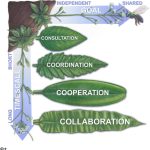Plant Science Research Weekly: May 26, 2023
Review: Stress-related biomolecular condensates in plants
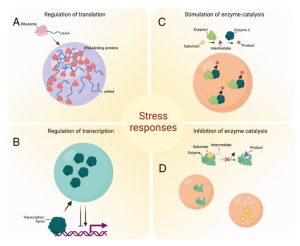 Biomolecular condensates are non-membrane-bound compartments containing proteins and RNAs with key functions in stress responses. In plants, they occur as several types with different properties and components, including stress granules and processing bodies. Protein domains such as prion-like domains and intrinsically-disordered regions provide stickiness and facilitate protein aggregation. Although much of what is known about biomolecular condensates is derived from studies in yeast and animal cells, our understanding of these processes in plants is accelerating rapidly. This review by Solis-Miranda et al. provides an overview of what is known in plants, including findings from proteomic and transcriptomic studies comparing different condensate types. Interestingly, many of the proteins in these structures are kingdom-specific, with only about 15% of plant proteins shared by yeast or animal structures. The review takes a close look at how these condensates contribute to stress resistance, and the potential to harness them for crop protection. Note: this topic is featured and two of the review authors are speaking at the ASPB Plant Biology conference in August 2023 https://plantbiology.aspb.org/plenaries/. Early registration ends soon. (Summary by Mary Williams @PlantTeaching) Plant Cell 10.1093/plcell/koad127
Biomolecular condensates are non-membrane-bound compartments containing proteins and RNAs with key functions in stress responses. In plants, they occur as several types with different properties and components, including stress granules and processing bodies. Protein domains such as prion-like domains and intrinsically-disordered regions provide stickiness and facilitate protein aggregation. Although much of what is known about biomolecular condensates is derived from studies in yeast and animal cells, our understanding of these processes in plants is accelerating rapidly. This review by Solis-Miranda et al. provides an overview of what is known in plants, including findings from proteomic and transcriptomic studies comparing different condensate types. Interestingly, many of the proteins in these structures are kingdom-specific, with only about 15% of plant proteins shared by yeast or animal structures. The review takes a close look at how these condensates contribute to stress resistance, and the potential to harness them for crop protection. Note: this topic is featured and two of the review authors are speaking at the ASPB Plant Biology conference in August 2023 https://plantbiology.aspb.org/plenaries/. Early registration ends soon. (Summary by Mary Williams @PlantTeaching) Plant Cell 10.1093/plcell/koad127
Update: Callose synthesis in plant development – an evolutionary insight
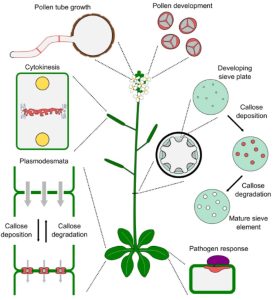 Callose is a polysaccharide with amorphous, gel-like properties that often serves as a transient matrix in plant cell walls. Callose deposition at plasmodesmata can regulate the movement of molecules between cells, transient callose deposition in phloem sieve elements occurs in response to stress, callose is deposited at the site at which some pathogens penetrate the host cell, and callose is instrumental in cell plate formation during cytokinesis. The contributions of callose and its synthesis by callose synthases (CalSs) are the focus of this Update by Ušák et a. Callose synthase is a large integral membrane protein encoded by a large gene family. There is some evidence that different family members have different functions. Furthermore, different subclades are more or less abundant across plant and algal lineages. The authors explore CasS phylogeny and expression in light of different forms of cytokinesis (centrifugal cytokinesis versus centripetal cleavage furrow), and highlight several unknowns in our understanding of CalSs in development. (Summary by Mary Williams @PlantTeaching) Plant Physiol. 10.1093/plphys/kiad274
Callose is a polysaccharide with amorphous, gel-like properties that often serves as a transient matrix in plant cell walls. Callose deposition at plasmodesmata can regulate the movement of molecules between cells, transient callose deposition in phloem sieve elements occurs in response to stress, callose is deposited at the site at which some pathogens penetrate the host cell, and callose is instrumental in cell plate formation during cytokinesis. The contributions of callose and its synthesis by callose synthases (CalSs) are the focus of this Update by Ušák et a. Callose synthase is a large integral membrane protein encoded by a large gene family. There is some evidence that different family members have different functions. Furthermore, different subclades are more or less abundant across plant and algal lineages. The authors explore CasS phylogeny and expression in light of different forms of cytokinesis (centrifugal cytokinesis versus centripetal cleavage furrow), and highlight several unknowns in our understanding of CalSs in development. (Summary by Mary Williams @PlantTeaching) Plant Physiol. 10.1093/plphys/kiad274
The HOS15-HDA9 complex associates with HYL1 to modulate miRNA expression in response to ABA signalling
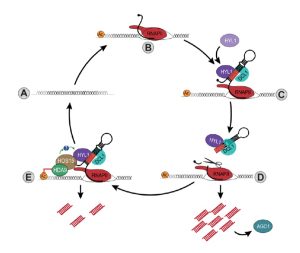 MicroRNAs (miRNAs) play a crucial role in plant cell homeostasis, particularly in response to environmental biotic and abiotic stresses. The transcription of miRNAs is mediated by RNA Polymerase II which generates the primary miRNA transcripts (pri-miRNAs). HYPONASTIC LEAVES 1 (HYL1) is a miRNA biogenesis protein indirectly associated with chromatin through the interaction with the nascent pri-miRNA. HIGH EXPRESSION OF OSMOTICALLY RESPONSIVE GENES 15 (HOS15) facilitates the recruitment of histone deacetylases to the promoter of the target genes together with its chromatin-acting partner HISTONE DEACETYLASE 9 (HDA9). Previous works suggest an interaction between the chromatin-remodelling machinery and pri-mRNA processing at transcriptional level. However, the interaction between the HOS15-HDA9 complex together with HYL1 and their functional relevance in ABA signalling remained unclear. In this work, Park et al., show that the ABA-induced recruitment of HOS15-HDA9 complex to the miRNA loci and the following silencing of MIRNA loci depended on the recognition of nascent pri-miRNAs by HYL1. As the authors observe, these findings “indicate that nascent pri-miRNAs serve as scaffolds for recruiting transcriptional regulators, specifically to MIRNA loci.” Understanding theses mechanism is crucial for elucidating the intersection between hormone pathways and epigenetic regulation that fine-tune gene expression in plants. (Summary by Eva Maria Gomez Alvarez @eva_ga96) Plant Cell 10.1093/plcell/koad132
MicroRNAs (miRNAs) play a crucial role in plant cell homeostasis, particularly in response to environmental biotic and abiotic stresses. The transcription of miRNAs is mediated by RNA Polymerase II which generates the primary miRNA transcripts (pri-miRNAs). HYPONASTIC LEAVES 1 (HYL1) is a miRNA biogenesis protein indirectly associated with chromatin through the interaction with the nascent pri-miRNA. HIGH EXPRESSION OF OSMOTICALLY RESPONSIVE GENES 15 (HOS15) facilitates the recruitment of histone deacetylases to the promoter of the target genes together with its chromatin-acting partner HISTONE DEACETYLASE 9 (HDA9). Previous works suggest an interaction between the chromatin-remodelling machinery and pri-mRNA processing at transcriptional level. However, the interaction between the HOS15-HDA9 complex together with HYL1 and their functional relevance in ABA signalling remained unclear. In this work, Park et al., show that the ABA-induced recruitment of HOS15-HDA9 complex to the miRNA loci and the following silencing of MIRNA loci depended on the recognition of nascent pri-miRNAs by HYL1. As the authors observe, these findings “indicate that nascent pri-miRNAs serve as scaffolds for recruiting transcriptional regulators, specifically to MIRNA loci.” Understanding theses mechanism is crucial for elucidating the intersection between hormone pathways and epigenetic regulation that fine-tune gene expression in plants. (Summary by Eva Maria Gomez Alvarez @eva_ga96) Plant Cell 10.1093/plcell/koad132
Unveiling the hot secrets of seed thermoinhibition: The endosperm’s role in plant survival
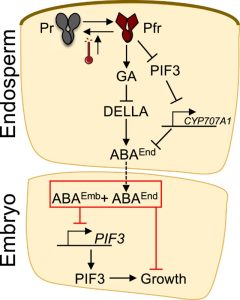 An important phase in a plant’s life cycle is transforming from embryo to seedling, when it transitions from a protected space inside the seed to a vulnerable seedling. The capacity of the seedling to tolerate its surroundings determines its survival and eventual reproductive success. In addition to dormancy, which prevents seed from sprouting until favourable environmental circumstances are met, high temperature-mediated inhibition of germination (thermoinhibition) adds another layer of regulation, allowing seeds to germinate during optimal reproductive seasons. Temperature sensing involves phytochromes, particularly phytochrome B (phyB), and phytochrome-interacting factors (PIFs). Recent research by Piskurewicz et al. indicates that thermoinhibition in Arabidopsis relies on the endosperm rather than the embryo. High temperature-mediated decreases in endospermic phyB signaling leads to increased accumulation and release of a plant hormone, abscisic acid (ABA). The process involves two parallel signaling pathways mediated by DELLA and PIFs, specifically PIF1, PIF3, and PIF5. These factors regulate the expression of genes involved in ABA synthesis and degradation. PIFs inhibit embryonic growth by allowing ABA to accumulate. PIF3-mediated ABA release maintains low levels of embryonic PIF3 expression, which inhibits embryonic growth. The work highlights the significance of phyB signalling in the endosperm for regulating the embryo-to-seedling transition and underscores the function of PIFs as crucial elements of this signalling pathway. (Summary by Rajarshi Sanyal, @rajarshi_sanyal) Nature Comms, 10.1038/s41467-023-36903-4.
An important phase in a plant’s life cycle is transforming from embryo to seedling, when it transitions from a protected space inside the seed to a vulnerable seedling. The capacity of the seedling to tolerate its surroundings determines its survival and eventual reproductive success. In addition to dormancy, which prevents seed from sprouting until favourable environmental circumstances are met, high temperature-mediated inhibition of germination (thermoinhibition) adds another layer of regulation, allowing seeds to germinate during optimal reproductive seasons. Temperature sensing involves phytochromes, particularly phytochrome B (phyB), and phytochrome-interacting factors (PIFs). Recent research by Piskurewicz et al. indicates that thermoinhibition in Arabidopsis relies on the endosperm rather than the embryo. High temperature-mediated decreases in endospermic phyB signaling leads to increased accumulation and release of a plant hormone, abscisic acid (ABA). The process involves two parallel signaling pathways mediated by DELLA and PIFs, specifically PIF1, PIF3, and PIF5. These factors regulate the expression of genes involved in ABA synthesis and degradation. PIFs inhibit embryonic growth by allowing ABA to accumulate. PIF3-mediated ABA release maintains low levels of embryonic PIF3 expression, which inhibits embryonic growth. The work highlights the significance of phyB signalling in the endosperm for regulating the embryo-to-seedling transition and underscores the function of PIFs as crucial elements of this signalling pathway. (Summary by Rajarshi Sanyal, @rajarshi_sanyal) Nature Comms, 10.1038/s41467-023-36903-4.
Decreased brassinosteroid signaling enhances grain yield in semi-dwarf wheat
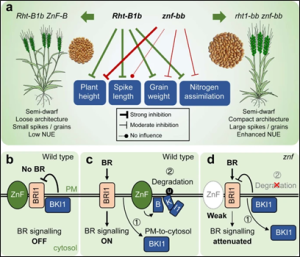 The green revolution revolutionized crop productivity through the adoption of genetic advancements, particularly focusing on genes like Reduced height-1 (Rht-1) in wheat and semi-dwarf1 (sd1) in rice, which optimized plant architecture. However, these changes lowered the green revolution varieties’ (GRVs) ability to use nitrogen efficiently, requiring more chemical fertilizers to make up for the low nitrate uptake. Through QTL analysis for thousand-grain weight (TGW) in a segregating wheat population of Heng597 (Heng) × Shi4185 (Shi), Song et al. identified a deleted fragment of about 500 kilobases termed the r-e-z deletion in the Heng population. This deletion resulted in the loss of three genes: Rht-B1b, EamA-B, and ZnF-B. The r-e-z haploblock deletion conferred advantageous agronomic traits to the Heng population, notably significantly improved nitrogen use efficiency. Furthermore, the NIL-Heng (Near-Isogenic Line carrying the Heng genetic background) exhibited a higher grain yield compared to NIL-Shi at varying planting densities, ranging from 10.6% to 13.8% with much higher resistance to lodging. Both Rht-B1b and ZnF-B were found to have effects on plant height and TGW, but in an antagonistic manner. The ZnF protein, characterized by a RING-finger domain in its carboxy terminus and seven transmembrane domains in its amino terminus, acts as a positive regulator of brassinosteroid (BR) signalling. ZnF degrades a crucial BR signalling inhibitor, BRI1 KINASE INHIBITOR 1 (BKI1), at the plasma membrane. Consequently, genotypes with the r-e-z deletion exhibit semi-dwarf height due to decreased BR signalling controlled by ZnF, as well as increased TGW due to the absence of the Rht-B1 gene. This study provides a new strategy to improve the GRVs by exploring ZnF as a new source for semi-dwarfisms. (Summary by Mahesh Kumar Panda @maheshkumarMnP) Nature 10.1038/s41586-023-06023-6
The green revolution revolutionized crop productivity through the adoption of genetic advancements, particularly focusing on genes like Reduced height-1 (Rht-1) in wheat and semi-dwarf1 (sd1) in rice, which optimized plant architecture. However, these changes lowered the green revolution varieties’ (GRVs) ability to use nitrogen efficiently, requiring more chemical fertilizers to make up for the low nitrate uptake. Through QTL analysis for thousand-grain weight (TGW) in a segregating wheat population of Heng597 (Heng) × Shi4185 (Shi), Song et al. identified a deleted fragment of about 500 kilobases termed the r-e-z deletion in the Heng population. This deletion resulted in the loss of three genes: Rht-B1b, EamA-B, and ZnF-B. The r-e-z haploblock deletion conferred advantageous agronomic traits to the Heng population, notably significantly improved nitrogen use efficiency. Furthermore, the NIL-Heng (Near-Isogenic Line carrying the Heng genetic background) exhibited a higher grain yield compared to NIL-Shi at varying planting densities, ranging from 10.6% to 13.8% with much higher resistance to lodging. Both Rht-B1b and ZnF-B were found to have effects on plant height and TGW, but in an antagonistic manner. The ZnF protein, characterized by a RING-finger domain in its carboxy terminus and seven transmembrane domains in its amino terminus, acts as a positive regulator of brassinosteroid (BR) signalling. ZnF degrades a crucial BR signalling inhibitor, BRI1 KINASE INHIBITOR 1 (BKI1), at the plasma membrane. Consequently, genotypes with the r-e-z deletion exhibit semi-dwarf height due to decreased BR signalling controlled by ZnF, as well as increased TGW due to the absence of the Rht-B1 gene. This study provides a new strategy to improve the GRVs by exploring ZnF as a new source for semi-dwarfisms. (Summary by Mahesh Kumar Panda @maheshkumarMnP) Nature 10.1038/s41586-023-06023-6
Extrachromosomal circular DNA mediated spread of herbicide resistance in interspecific hybrids of pigweed
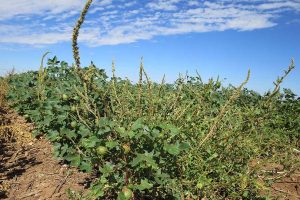 Extrachromosomal circular DNA (eccDNA) is a type of double-stranded circular DNA that is derived from chromosomes. High copy number and expression level of eccDNA encoding 5-enolpyruvylshikimate-3-phosphate synthase (EPSPS) have been linked with glyphosate resistance in pigweed (Amaranthus spp). Previous studies have reported the apparent transfer of glyphosate resistance across related species of pigweed and have linked this with the possibility of a pollen-mediated eccDNA transfer. Here, Koo et al. used fluorescent in situ hybridization to confirm this hypothesis. They found that two pigweed species (Amarathus spinosus and Amarathus palmeri) carry similar eccDNA which conferred their glyphosate resistance that was likely acquired through interspecific hybridization by pollen transfer. Further experiments confirmed the ability of A. palmeri’s eccDNA to be transferred across species. Ultimately, the authors showed that eccDNA enables copy number variation in non-reproductive cells which, under strong selection pressure, may drive rapid adaptive evolution and acquisition of glyphosate resistance. (Summary by Abdulkabir Omeiza Abdulmalik @Omeiza_PlantDoc) Plant Physiol. 10.1093/plphys/kiad281
Extrachromosomal circular DNA (eccDNA) is a type of double-stranded circular DNA that is derived from chromosomes. High copy number and expression level of eccDNA encoding 5-enolpyruvylshikimate-3-phosphate synthase (EPSPS) have been linked with glyphosate resistance in pigweed (Amaranthus spp). Previous studies have reported the apparent transfer of glyphosate resistance across related species of pigweed and have linked this with the possibility of a pollen-mediated eccDNA transfer. Here, Koo et al. used fluorescent in situ hybridization to confirm this hypothesis. They found that two pigweed species (Amarathus spinosus and Amarathus palmeri) carry similar eccDNA which conferred their glyphosate resistance that was likely acquired through interspecific hybridization by pollen transfer. Further experiments confirmed the ability of A. palmeri’s eccDNA to be transferred across species. Ultimately, the authors showed that eccDNA enables copy number variation in non-reproductive cells which, under strong selection pressure, may drive rapid adaptive evolution and acquisition of glyphosate resistance. (Summary by Abdulkabir Omeiza Abdulmalik @Omeiza_PlantDoc) Plant Physiol. 10.1093/plphys/kiad281
Inclusive collaboration across plant physiology and genomics: Now is the time!
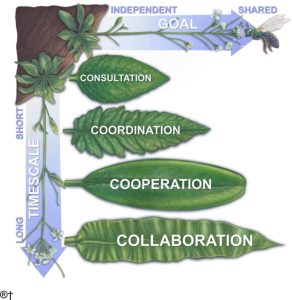 Research and discovery rely on teamwork and collaboration, yet many academic structures don’t support or reward such models. Additionally, the significant challenges addressed by plant scientists go beyond the expertise of one PI or lab, further highlighting the need for research teams that span disciplinary boundaries. In this recent white paper, the Interdisciplinary Plant Science Consortium reports on a set of workshops that addressed how to support inclusive collaborations, and recommendations to train scientists to become more inclusive and collaborative. The article discusses strategies to identify partners and funding sources, but also recommends new approaches to support and encourage collaboration. For example, large numbers of faculty and students at research less-intensive institutions (e.g., minority serving institutions, primarily undergraduate institutions, etc.) have much to contribute to collaborative research if provided with funding and training opportunities; increasing flexibility in funding programs can support such efforts. Another challenge is that at many universities the tenure and promotion systems still focus on independent, rather than collaborative efforts; likewise, most prestigious awards recognize individuals rather than groups. The authors also point out that journals can support interdisciplinary collaborative research through focus issues and providing a dedicated submission and review process for submissions derived from such projects. (Summary by Mary Williams @PlantTeaching) Plant Direct 10.1002/pld3.493
Research and discovery rely on teamwork and collaboration, yet many academic structures don’t support or reward such models. Additionally, the significant challenges addressed by plant scientists go beyond the expertise of one PI or lab, further highlighting the need for research teams that span disciplinary boundaries. In this recent white paper, the Interdisciplinary Plant Science Consortium reports on a set of workshops that addressed how to support inclusive collaborations, and recommendations to train scientists to become more inclusive and collaborative. The article discusses strategies to identify partners and funding sources, but also recommends new approaches to support and encourage collaboration. For example, large numbers of faculty and students at research less-intensive institutions (e.g., minority serving institutions, primarily undergraduate institutions, etc.) have much to contribute to collaborative research if provided with funding and training opportunities; increasing flexibility in funding programs can support such efforts. Another challenge is that at many universities the tenure and promotion systems still focus on independent, rather than collaborative efforts; likewise, most prestigious awards recognize individuals rather than groups. The authors also point out that journals can support interdisciplinary collaborative research through focus issues and providing a dedicated submission and review process for submissions derived from such projects. (Summary by Mary Williams @PlantTeaching) Plant Direct 10.1002/pld3.493



